Books
by
Byron Brown
Order Here |
|
“The motivation
here is really to do something that has some aesthetic value. I’m
not particularly concerned about having a house. I don’t build this
to own a home. I build it because I like doing sculpture.” - Robert
Bruno, 2007.
One
of the true tests for qualifying an artist’s effort is to judge whether
the work produced is of the sort that simultaneously astounds, inspires,
surprises and delights. Those few artists whose works do affect us
in these ways are certainly in possession of a level of ability that
the rest of us can only marvel at and envy. Some would call this talent
genius. Others might witness the hand of the Lord in the creation
of these individuals because their work illustrates a level of creativity
that surely could spring from no other earthly source. And Texas,
thankfully, is the proud possessor of several of just this type of
artist. One of whom, the sculptor and architect Robert Bruno,
has bequeathed to us his Steel House, sometimes referred to
as “The Metal Mansion”, just outside of Lubbock
in Ransom Canyon. |
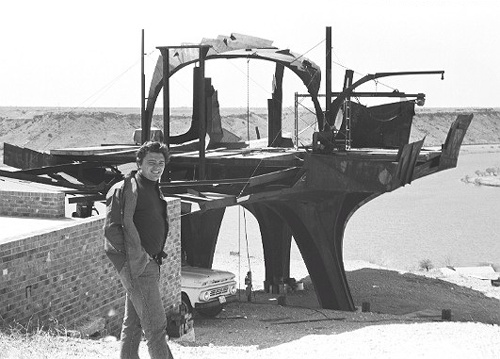 |
Robert Bruno
in 1974
Photo courtesy www.robertbruno.com |
| Bruno, born in
Los Angeles in 1945 and making his way to Texas Tech University after
some time in Mexico began design work on the Steel House in 1973.
The actual construction was begun a year later and it was then that
I first heard of the project. In fact, the whole Lubbock
community heard of it then. The frame (if we can rightly call it that)
was begun as three giant, arachnid-like legs. You might well imagine
the anxiety this caused a very puritan society that was already feeling
the sting of both the Vietnam chaos and the loss of Nixon- an icon
of the prevailing, local sentiments. Portrayed in the local press
as “weird”, “out of place” or just “ugly”, Bruno’s house became quickly
a fixture as extraordinary as a freak show at the circus. However
most residents, even an eleven-year-old with a tacit taste for the
bizarre, missed the point at first. As Bruno explained, he was only
expanding on one of his existing concepts. “The evolution of this
house is that I’d actually been working on other sculptures prior
to this and one which was quite large was large enough to stand under.
And it seemed like a pleasant environment and if I could capture that
same feel on a little bit larger scale then I could live in it.” |
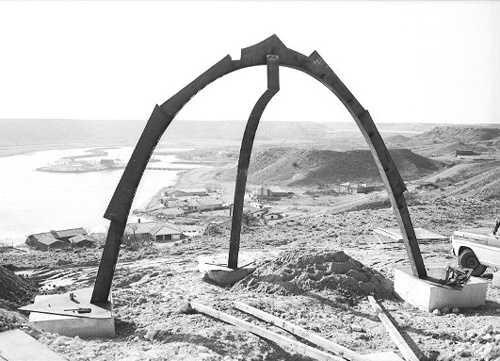 |
Steel House Framework
Photo courtesy www.robertbruno.com |
| The exterior
of the sculpture (a term used to describe the house by Bruno as well
as several other artists and critics) has been typified as a “metal
pig” or, more usually, as a “spaceship”. While the structure does
appear as though it may have landed on its location the natural materials,
comprised wholly of º” metal sheeting, used in construction suggest
that it just as easily could have grown from the soil underneath.
(If green is “Green” then surely brown can be “Green" too?) By
contrast nowadays, the sculpture does appear somewhat misplaced. But
when considering that in 1974 that stretch of space in Ransom
Canyon was largely undeveloped, the structure would have seemed
much more attuned to its surrounding environment. Nevertheless, even
today the exterior exhibits a fluidity of design that allows a spectator
to view large portions of the area from a single vantage point. Almost
every angle is smoothed and while the constancy of color denies a
single focal point these same components compel the eye to sweep from
one end or side to the next, to keep moving until the entirety of
the faÁade is a whole mental image. This is, evidently, what Bruno
envisioned back in the initial stages, “One of the things that makes
this a somewhat different structure than most is that it doesn’t have
a skeleton with the skin draped over it. This skin is the structure.
So, the outside of this house is what holds it all up.” |
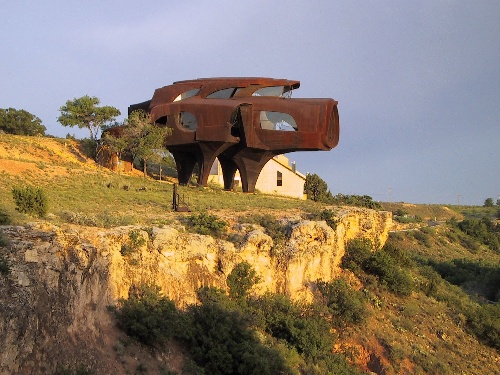 |
Steel House Interior
Photo courtesy www.robertbruno.com |
| The interior
of Steel House is majestic. Indeed, I have frequently had the
impression that Bruno’s vision began inside out, as it were. Originally
planned as a single story home the project grew as time passed and
inspiration matured into action. Today the sculpture is a three-story
magnus opus with some of the “legs” standing in for the first
floor, e.g. one of the legs houses the home’s library, another the
home’s elevator and a third slated as a wine cellar. The space atop
the supports (even Bruno himself was unsure about the total interior
square footage; he thought it somewhere between 2000-2700 square feet)
is separated by a spiral staircase and Gothic columns that, again,
are smoothed and rounded to lessen the severity of both the material
and texture. A portion of the window’s glass is colored in order to
accentuate and augment the natural elements within. At times futuristic
(think ‘Logan’s Run’) and at others medieval (Notre Dame), the interior
of the sculpture brings to mind the expanse and geometry of Duchamp’s
Nude Descending a Staircase, No. 2. Coupling disparate styles
however, was the juxtaposition that Bruno was concerned with from
the beginning, “I’m interested in giving it a somewhat organic quality-somewhere
between animal and machine.” And so the materials used to create the
structure’s interior range from metal to wood to glass to plaster,
much of it scrap from other building projects around the west Texas
area. These materials were intentionally left raw and even somewhat
primitive. When fused and welded together though they combine to create
an aesthetic that forces the viewer to re-establish perceptions of
space and prejudice. In fact, the house is meant, with its mostly
natural materials and slightly Spartan exterior, to emulate and mirror
the rustic environment that it initially inhabited. |
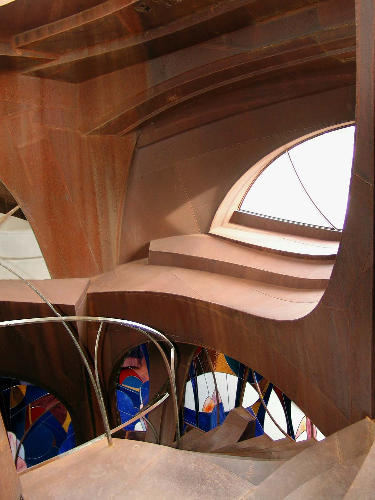 |
Metal, wood,
glass and plaster
Photo courtesy www.robertbruno.com |
Working in much
the same manner as Jackson Pollock, Bruno’s Steel House was, it seems,
forever changing and growing; never completed but always near some
terminus. The construction, the actual work, was the main component
of the endeavor. Again, planned as a one-floor house, the work was
constantly being updated and modified until it reached its current
three-story status. Bruno, by interviews in various newspapers and
magazines, was frequently quoted as saying that the house would be
ready for occupancy “in about a year”. Like Gaudi’s Sagrada Familia,
the famous Spanish cathedral that, after 128 years, is still under
construction, the Steel House was still witnessing additions and modifications
in 2008 when Bruno passed away after 35 years of overseeing construction
of this mammoth sculpture. It seems though that he might have had
this trajectory in the back of his mind the entire time. As he stated,
“In this build as you go, one of the things that happens also is that
you find yourself coming back and cutting out something that you did
6-7 years before and it looked right at the time but in the context
of something new that you’re doing, a modification would look even
better.”
Perhaps this confluence of philosophies, the architect and the sculpture,
is what keeps Steel House moving forward, keeps it alive. As an artist
Bruno seemed content, appeared satisfied more with the building of
the house than its actual completion. In a 2008 interview in the Financial
Times Bruno explained his thoughts on the process of architectural
design and in the process illuminated an underlying artistic principle,
“You could say that architectural models are the real buildings, and
that most of what is built today is just a dishonest replica of that.
In my house, the structure is the shell; there’s no pretense, no deception.”
And then again, in another interview, when Bruno was trying to describe
the function of the separate rooms, the space was still undetermined,
“This room could be a bedroom but I haven’t really decided what it’s
going to be.” |
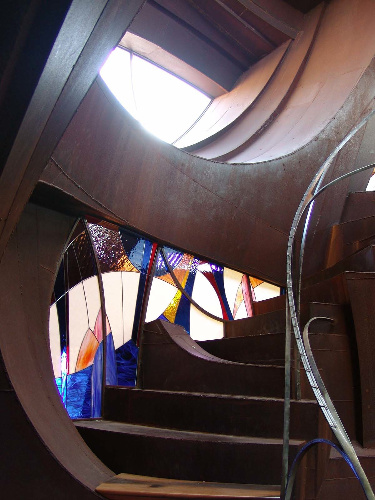 |
Spiral Staircase
Photo courtesy www.robertbruno.com |
|
Robert Bruno
could not have chosen a more exacting location for his Steel House.
An artist full of the philosophies of opposites and juxtapositions
he planted his sculpture in exactly that part of the state where
it would attract the most attention. Akin to those Cadillacs
near Amarillo with their trunks sinking into the ground, Bruno’s
house is sure to always grab notice. And while it is very disquieting
to think that he has passed on I believe he would be very glad to
consider that everyone who sees his work for the first time will
immediately find need to readjust reality. It will be in this manner
that the sculpture continues to expand and grow.
Special thanks to Ben Britt for video diary of Steel House.
Website: www.robertbruno.com
© Byron Browne
Notes From Over Here May
5, 2010 Column
|
|
|
